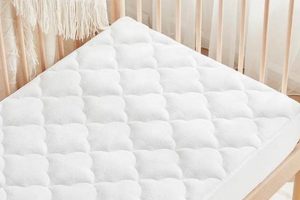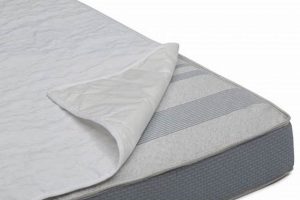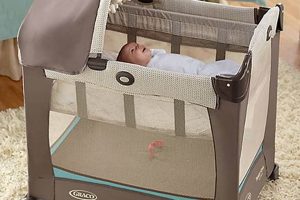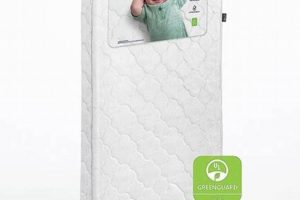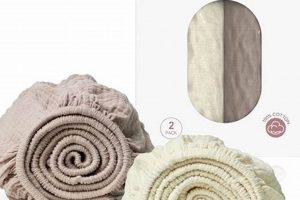A standard mattress for a toddler’s bed is dimensionally different from a mattress intended for a smaller bed frame designed for infants. Size, construction materials, and safety standards distinguish these products intended for different developmental stages. One is designed to support the growing child in a larger bed as they move away from the confined safety of infancy; the other is specifically crafted to provide a firm, safe sleep surface for babies.
The availability of appropriate sleep surfaces for different age groups is significant for several reasons, not least of which is safety. Historically, inadequate attention to mattress firmness and sizing has contributed to infant suffocation risks. Selecting the correct product can minimize these risks, promoting safer sleep environments. Furthermore, proper support contributes to healthy skeletal development in both infants and toddlers.
The following sections will delve into the specific size variations, the construction differences including materials used and firmness levels, and the safety regulations that govern each product, providing a detailed comparative analysis to inform purchasing decisions.
Guidance on Mattress Selection
Selecting the appropriate mattress requires careful consideration of several factors. These guidelines emphasize key aspects to ensure both safety and comfort for the intended user.
Tip 1: Verify Dimensions. The dimensions must precisely match the bed frame. Gaps between the mattress and frame create potential entrapment hazards. Measure the interior of the bed frame before purchase.
Tip 2: Assess Firmness. Infant mattresses necessitate high firmness levels to reduce the risk of suffocation. Conversely, toddler mattresses may offer slightly more give to enhance comfort, but firmness should remain a primary consideration.
Tip 3: Review Safety Certifications. Look for certifications from reputable organizations, such as GREENGUARD Gold, indicating the mattress has been tested for chemical emissions and meets stringent safety standards.
Tip 4: Consider Material Composition. Opt for hypoallergenic materials and avoid those treated with potentially harmful chemicals. Natural fibers like cotton or wool can offer breathability and reduce allergen exposure.
Tip 5: Evaluate Weight and Density. A higher density mattress generally indicates greater durability and support. However, ease of handling should also be considered, particularly when changing sheets or moving the mattress.
Tip 6: Inspect Seam Construction. Well-constructed seams prevent premature wear and tear. Reinforce the seams to extend the life of the product.
Tip 7: Adhere to Age Recommendations. Follow the manufacturer’s guidelines regarding appropriate age and weight limits for each mattress type. Do not transition a child to a larger mattress prematurely.
Selecting mattresses based on these factors promotes safer and more comfortable sleep environments for children at various developmental stages. Careful consideration of size, firmness, materials, and certifications is paramount.
The subsequent section will address common misconceptions associated with mattress selection, offering clarification and further guidance.
1. Size Dimensions
Size dimensions represent a primary differentiator when comparing mattresses designed for infants and older children. These dimensions influence not only the fit within the corresponding bed frame but also the overall safety and comfort provided to the user. Adherence to standardized dimensions is paramount to prevent hazards associated with ill-fitting mattresses.
- Crib Mattress Standard Dimensions
Crib mattresses typically adhere to standardized dimensions mandated to ensure a snug fit within a standard-sized crib. The accepted measurement is approximately 28 inches wide by 52 inches long. This standardization aims to eliminate gaps between the mattress and crib frame, thereby minimizing the risk of infant entrapment. Deviations from these dimensions can compromise the integrity of the sleep environment, potentially leading to hazardous conditions.
- Twin Mattress Standard Dimensions
A twin mattress, intended for older children and adults, possesses significantly larger dimensions, typically measuring around 38 inches wide by 75 inches long. These expanded dimensions accommodate the greater physical size and developmental needs of a growing child. The increased surface area provides more room for movement during sleep. Placing a twin mattress in a crib frame is physically impossible and conceptually inappropriate given the differing intended users.
- Dimensional Variability and Frame Compatibility
While standard dimensions exist, slight variations can occur among manufacturers. It is essential to measure the interior dimensions of the bed frame accurately before selecting a mattress. A discrepancy of even an inch can create hazardous gaps. For cribs, regulators test and certify compliance with a standard of no more than a two-finger gap between mattress and crib sides.
- Implications for Safety and Comfort
Appropriate sizing affects safety and comfort. A crib mattress must fit snugly within the crib frame to prevent entrapment and suffocation hazards. A twin mattress must fit securely within the bed frame. Oversized mattresses will bow or warp, and undersized options will shift. Selection predicated on accurate size promotes a safer and more comfortable sleep experience for both infants and older children.
The distinctions in size dimensions reflect the fundamental differences in the intended use cases for infant and children’s mattresses. Crib mattresses prioritize safety within the confines of a crib, while twin mattresses emphasize comfort and support for larger, more mobile children. Therefore, carefully considering the dimensional specifications of both the mattress and bed frame is vital for creating a safe and supportive sleep environment.
2. Firmness Standards
Firmness standards represent a critical aspect distinguishing crib mattresses from twin mattresses, directly influencing infant safety and sleep quality. The correlation between mattress firmness and the risk of Sudden Infant Death Syndrome (SIDS) is well-documented; consequently, crib mattresses adhere to significantly stricter firmness criteria than those designed for older children. This difference stems from the physiological vulnerability of infants, whose developing musculature and limited mobility necessitate a firm, flat sleep surface to minimize the risk of airway obstruction.
Twin mattresses, intended for older children and adults, typically exhibit a broader range of firmness levels. These mattresses may incorporate cushioning layers for enhanced comfort, a characteristic generally absent in crib mattresses. The selection of a less firm mattress for older children reflects their greater ability to adjust their sleeping position and their reduced susceptibility to suffocation risks associated with softer surfaces. However, even within the twin mattress category, firmness must be appropriate for the user’s age, weight, and developmental stage. Excessively soft mattresses may not provide adequate spinal support, particularly for growing children. For instance, a child transitioning from a toddler bed to a twin bed might require a firmer twin mattress initially to maintain proper spinal alignment, gradually transitioning to a softer mattress as they mature.
Therefore, adherence to established firmness standards is paramount in the design and selection of both crib and twin mattresses. Deviation from these standards can have adverse consequences, ranging from increased SIDS risk in infants to inadequate spinal support in older children. Understanding the underlying rationale for these differencesrooted in developmental physiology and safety considerationsis essential for promoting safe and healthy sleep environments across different age groups.
3. Safety Regulations
The distinction between mattress types extends significantly into the realm of mandatory safety regulations. Crib mattresses are subject to stringent standards dictated by governmental bodies and industry organizations, with a primary focus on preventing infant suffocation and related hazards. These regulations dictate specific requirements for mattress firmness, construction materials, and labeling. For instance, the Consumer Product Safety Commission (CPSC) establishes and enforces federal safety standards for crib mattresses, encompassing aspects such as flammability and the presence of harmful chemicals. Failure to adhere to these regulations can result in substantial penalties for manufacturers and retailers.
In contrast, mattresses intended for older children, including twin mattresses, are subject to a different, often less rigorous, set of safety standards. While flammability standards are generally consistent across all mattress types, requirements pertaining to firmness, size tolerances, and chemical emissions may differ. This disparity reflects the reduced risk profile associated with older children, who possess greater mobility and cognitive awareness, thereby lessening the likelihood of suffocation or entrapment. The lack of strict oversight of mattresses for older children does not negate the importance of safety considerations. Parents and caregivers must remain vigilant in assessing mattress suitability, ensuring adequate support, and avoiding products with known hazards.
Ultimately, safety regulations serve as a critical framework for minimizing risks associated with mattresses, particularly those designed for vulnerable populations such as infants. Understanding the specific regulations governing crib mattresses versus twin mattresses empowers consumers to make informed purchasing decisions, selecting products that prioritize the well-being of the child. The presence of certifications from reputable organizations, coupled with careful scrutiny of product labeling, represents essential steps in mitigating potential hazards and fostering a safe sleep environment.
4. Material Composition
Material composition is a primary differentiating factor, influencing factors such as safety, durability, comfort, and regulatory compliance. The materials used in each significantly impact the product’s suitability for the intended age group.
- Core Materials and Support
Crib mattresses often employ high-density foam or innerspring systems to achieve the required firmness. These materials provide a stable, unyielding surface to minimize suffocation risks. Twin mattresses, while potentially incorporating similar materials, may also include softer components like memory foam or latex to enhance comfort for older children. The core structure in a twin mattress may also feature varying coil counts and configurations to provide targeted support.
- Cover Fabrics and Breathability
The cover fabrics differ based on the target demographic. Crib mattress covers typically prioritize waterproof and hypoallergenic properties to protect against spills and allergens. Materials like vinyl or polyurethane laminates are common. Twin mattresses may utilize softer, more breathable fabrics such as cotton or bamboo blends to enhance comfort and temperature regulation. The breathability aspect is crucial for both, but particularly for crib mattresses, to reduce the risk of overheating.
- Flame Retardants and Chemical Treatments
Regulations mandate flame retardant properties in both mattress types. However, the specific chemicals used and their application methods vary. Crib mattresses face increased scrutiny regarding chemical emissions due to infants’ heightened sensitivity. Manufacturers increasingly opt for inherently flame-resistant materials or barrier fabrics to minimize chemical exposure. Twin mattresses also adhere to flammability standards, but the range of acceptable treatments may be broader.
- Adhesives and Binding Agents
The adhesives used to bind the various layers of a mattress together are an often-overlooked aspect. Crib mattresses necessitate non-toxic, low-VOC (Volatile Organic Compound) adhesives to mitigate potential health risks. Twin mattresses should ideally also utilize low-VOC adhesives, though the regulatory pressure may be less stringent. The type and quantity of adhesives contribute to the overall air quality within the sleeping environment.
The selection of materials in both types is driven by the need to balance safety, comfort, and durability, with crib mattresses prioritizing safety and firmness above all else due to the vulnerability of infants. Understanding these material differences informs appropriate mattress selection that aligns with specific developmental and regulatory considerations.
5. Weight Capacity
Weight capacity is a critical specification that differentiates mattresses intended for infants and older children. It reflects the structural integrity and support capabilities, directly impacting safety and longevity. Disregarding weight capacity can compromise the mattress’s effectiveness, potentially leading to unsafe sleep conditions.
- Maximum Infant Weight on Crib Mattresses
Crib mattresses are engineered to support infants, with weight limits typically not exceeding 50 pounds. This limit considers the average weight range of infants and toddlers using cribs. Exceeding this weight can compromise the mattress’s firmness, increasing the risk of suffocation. Furthermore, overstressing the internal structure can lead to premature wear or structural failure, negating the intended safety features.
- Weight Range Accommodation on Twin Mattresses
Twin mattresses are designed to accommodate a broader range of weights, often supporting individuals up to 250 pounds or more, depending on the construction and materials. This range aligns with the weight of older children, adolescents, and even adults. The increased weight capacity necessitates a more robust internal support system, including higher coil counts in innerspring models or denser foam cores in foam mattresses.
- Impact on Mattress Durability and Lifespan
Exceeding the designated weight capacity reduces the lifespan of both mattress types. Overloading a crib mattress can cause sagging or compression of the foam, diminishing its firmness. Similarly, overloading a twin mattress can result in premature wear, reduced support, and potential structural damage. Adherence to weight limits ensures the mattress maintains its integrity and continues to provide adequate support throughout its expected lifespan.
- Safety Implications of Exceeding Weight Limits
Beyond durability, exceeding weight limits poses safety risks. On a crib mattress, excessive weight can create indentations or pockets that increase the risk of infant suffocation. On a twin mattress, inadequate support can lead to discomfort, poor spinal alignment, and potential back pain. Strict adherence to recommended weight capacities is paramount to mitigating potential health and safety hazards.
The differing weight capacities illustrate the fundamental differences in design and intended use. Crib mattresses prioritize safety and firmness for infants, while twin mattresses emphasize support and durability for older children and adults. Disregarding weight limits can undermine the performance and safety of either, reinforcing the need for informed selection based on the user’s specific needs.
6. Intended Use
The rationale behind differing mattress types is inherently linked to the developmental stage and associated needs of the user. Intended use dictates specific design parameters, material choices, and safety certifications of crib and twin mattresses.
- Infant Sleep Safety
The primary intended use of a crib mattress is to provide a safe sleep environment for infants. This translates to strict requirements for firmness to minimize the risk of Sudden Infant Death Syndrome (SIDS), as well as size specifications to prevent entrapment between the mattress and crib frame. Materials are selected with infant sensitivities in mind, prioritizing non-toxic, hypoallergenic options. The design inherently limits mobility, keeping the infant securely positioned.
- Toddler and Child Comfort and Support
Twin mattresses are designed to support older children, adolescents, and adults. Comfort and spinal support become paramount, reflected in the wider range of available firmness levels and the inclusion of materials like memory foam or latex. The larger surface area accommodates movement and different sleeping positions. Durability is a key consideration, given the increased weight and activity levels of older children.
- Developmental Stage Considerations
Intended use aligns with developmental stages. Crib mattresses cater to the needs of newborns and infants with limited motor control. Twin mattresses cater to the needs of children who are more mobile, capable of repositioning themselves, and who require adequate spinal support as they grow. The transition from crib to twin mattress marks a significant milestone, reflecting increased independence and physical maturity.
- Adaptability and Long-Term Use
While crib mattresses have a defined period of use, typically lasting until the child transitions to a toddler bed or twin bed, twin mattresses offer greater adaptability and extended lifespan. They can be used throughout childhood, adolescence, and even into adulthood. The versatility of a twin mattress necessitates more durable construction and a wider range of support capabilities.
The divergence in intended use profoundly shapes the design and functionality of crib and twin mattresses. Each type is tailored to meet the specific needs and safety considerations of its respective user group, reflecting a commitment to promoting safe and comfortable sleep environments across different developmental stages. Proper selection based on intended use remains essential.
7. Lifespan Expectancy
Lifespan expectancy represents a key differentiating factor in the comparison of twin mattresses versus crib mattresses, driven by differing use patterns, material compositions, and inherent design parameters. A crib mattress, intended for a finite period of use during infancy, typically exhibits a shorter lifespan than a twin mattress designed for extended use throughout childhood and adolescence. The expected duration of utility directly influences manufacturing decisions, material choices, and the overall cost-benefit analysis for consumers. For instance, a crib mattress may prioritize safety and hygiene over long-term durability, as its use is limited to a relatively short timeframe. Conversely, a twin mattress prioritizes durability and long-term support to accommodate a growing child for several years.
The materials used in mattress construction directly correlate with lifespan expectancy. Crib mattresses often feature waterproof or water-resistant covers to manage infant-related spills and accidents, contributing to hygiene but potentially limiting breathability and long-term structural integrity. Twin mattresses, while also requiring durability, may incorporate more breathable fabrics and cushioning materials designed for extended comfort. In terms of support cores, both innerspring and foam mattresses exhibit varying degrees of durability. High-density foam cores generally offer greater resistance to compression and sagging, extending the lifespan of both crib and twin mattresses. The lifespan of either can be extended through use of mattress protectors.
Ultimately, the lifespan expectancy represents a crucial consideration when selecting appropriate mattresses for different developmental stages. Crib mattresses, with their shorter lifespan, require meticulous attention to safety and hygiene. Twin mattresses, designed for extended use, demand a balance of comfort, support, and durability. Understanding these factors allows consumers to make informed purchasing decisions, optimizing both the safety and value of sleep surfaces for children.
Frequently Asked Questions
This section addresses common inquiries regarding the selection and use of mattresses designed for infants and older children, emphasizing key safety considerations and product distinctions.
Question 1: What are the dimensional differences?
A crib mattress adheres to standardized dimensions of approximately 28 inches by 52 inches to ensure a secure fit within a standard crib frame. A twin mattress measures approximately 38 inches by 75 inches, designed for a twin-sized bed frame and older children.
Question 2: Why is firmness crucial for a crib mattress?
High firmness is essential in a crib mattress to minimize the risk of Sudden Infant Death Syndrome (SIDS). A firm surface prevents the infant from sinking into the mattress and potentially suffocating.
Question 3: Are flame retardants used in both mattress types?
Yes, both crib and twin mattresses must meet federal flammability standards, often necessitating the use of flame retardants. The specific chemicals and application methods may vary.
Question 4: Can a crib mattress be used for a toddler bed?
A crib mattress is typically too small for a standard toddler bed, which often uses a twin-sized mattress. While some toddler beds use crib mattresses, be certain of the size needed.
Question 5: What safety certifications should be considered?
Look for certifications such as GREENGUARD Gold, which indicates the mattress has been tested for chemical emissions. Certifications from the Juvenile Products Manufacturers Association (JPMA) signify adherence to safety standards.
Question 6: How does weight capacity differ?
Crib mattresses have a lower weight capacity, generally up to 50 pounds, suitable for infants. Twin mattresses accommodate a broader weight range, typically up to 250 pounds or more.
In summary, distinctions in size, firmness, safety regulations, and weight capacity underscore the importance of selecting the appropriate product based on the child’s age, developmental stage, and intended use.
The subsequent section will offer a concluding summary, reinforcing key recommendations and emphasizing the importance of informed decision-making in mattress selection.
Conclusion
The preceding analysis has elucidated the critical distinctions between a twin mattress and a crib mattress. Size dimensions, firmness standards, safety regulations, material composition, weight capacity, intended use, and lifespan expectancy all contribute to the fundamental differences between these sleep surfaces. The crib mattress is designed explicitly for infant safety, prioritizing firmness and minimizing potential hazards. Conversely, the twin mattress caters to the needs of older children and adolescents, balancing comfort, support, and durability.
The informed selection of a mattress suitable for the user’s developmental stage remains paramount. A deviation from established guidelines or a disregard for safety regulations can have significant consequences. Therefore, diligent research, careful consideration of product specifications, and adherence to recommended usage parameters are imperative to ensure a safe and supportive sleep environment for children and infants.


